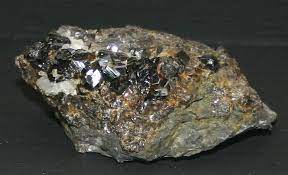
Tin ore, a fascinating mineral with a rich history, has played a significant role in shaping human civilization. Tin ore, also known as cassiterite, is a valuable mineral composed primarily of tin oxide (SnO2). It is a lustrous, dark-brown to black-colored crystal with a high density and Mohs hardness of 6 to 7. With a chemical formula of SnO2, it contains around 78.8% tin by weight, making it the primary source of tin extraction worldwide. Tin ore is commonly found in granite, pegmatite, and alluvial deposits, where it forms as a result of hydrothermal processes.
Tin ore holds a significant place in human history, dating back thousands of years. Its discovery and use can be traced to ancient civilizations such as the Mesopotamians, Egyptians, and Romans. The Bronze Age, characterized by the use of bronze, owes its existence to tin ore. This mineral played a pivotal role in the development of tools, weapons, and various alloys, including bronze, which revolutionized warfare and trade.
Tin ore is one of the most valuable minerals found in Nigeria. With its numerous applications in various industries, tin has played a significant role in the economic development of the country. This article explores the location of tin ore deposits in Nigeria and highlights its uses in different sectors.
Location of Tin Ore Deposits
Tin ore deposits are primarily found in the northern and central parts of Nigeria. The main areas with significant tin reserves include Plateau, Nasarawa, Bauchi, and Kano states.
These regions are collectively referred to as the Tin Belt of Nigeria due to the abundance of tin-bearing minerals found there. The Jos Plateau, located in Plateau State, is particularly renowned for its rich tin deposits.
Geological Formation of Tin Ore Deposits
Tin ore deposits in Nigeria are associated with the Younger Granite rocks, which were formed during the Pan-African orogeny, around 600 million years ago. These granitic rocks provided the necessary conditions for the concentration of tin-bearing minerals through magmatic processes. The tin-bearing minerals, mainly cassiterite (SnO2), are found in association with other minerals such as wolframite, tantalite, and columbite.
Mining and Production
Historically, tin mining in Nigeria dates back to the colonial era when the British government recognized the country's potential as a major tin producer. Large-scale mining operations were established, and Nigeria became one of the world's leading tin producers in the 1960s. However, due to various factors such as the decline in tin prices and the discovery of oil, tin mining witnessed a significant decline.
Currently, tin mining in Nigeria is predominantly carried out by artisanal and small-scale miners. These miners use rudimentary methods such as panning, open-pit mining, and sluicing to extract tin ore from the earth. The lack of modern mining techniques and infrastructure poses challenges to efficient and sustainable tin production in the country.
Uses of Tin
Tin has a wide range of applications across various industries, making it a valuable resource in Nigeria and globally. Some of the key uses of tin include:
Electronics and Electrical Industry: Tin is widely used in the electronics and electrical industry due to its excellent soldering properties. It is a crucial component in the production of solder, which is used to join electronic components on circuit boards. Tin-coated copper wires are also used extensively in the electrical sector.
Packaging Industry: Tin is commonly used as a coating material for steel cans in the packaging industry. This tin-plating process prevents corrosion and enhances the shelf life of canned food and beverages. Tin cans are lightweight, durable, and easily recyclable, making them a preferred choice for packaging.
Alloys and Metal Coatings: Tin is alloyed with other metals to create various useful materials. For example, bronze, which is an alloy of tin and copper, is widely used in the manufacturing of statues, medals, and musical instruments. Tin is also employed as a protective coating for other metals, preventing them from rusting or corroding.
Chemical Industry: Tin compounds find applications in the chemical industry. Stannous chloride (SnCl2) is used in the manufacture of dyes, pigments, and pharmaceuticals. Tin oxide (SnO2) is utilized as a catalyst in certain chemical reactions.
Solar Energy: Tin is a crucial component in the production of thin-film solar cells. These cells are lightweight and flexible, making them suitable for various applications, including portable electronic devices and building-integrated photovoltaics.
In conclusion, Tin ore deposits in Nigeria, primarily located in the northern and central regions, have played a significant role in the country's economic development. The Jos Plateau and other areas within the Tin Belt have been the main sources of tin production. Despite the challenges faced by the mining industry, tin continues to be a valuable resource due to its wide range of applications in electronics, packaging, alloys, chemicals, and renewable energy.
The sustainable development of Nigeria's tin resources, with the implementation of modern mining techniques and infrastructure, can contribute to the country's industrial growth and generate employment opportunities.























